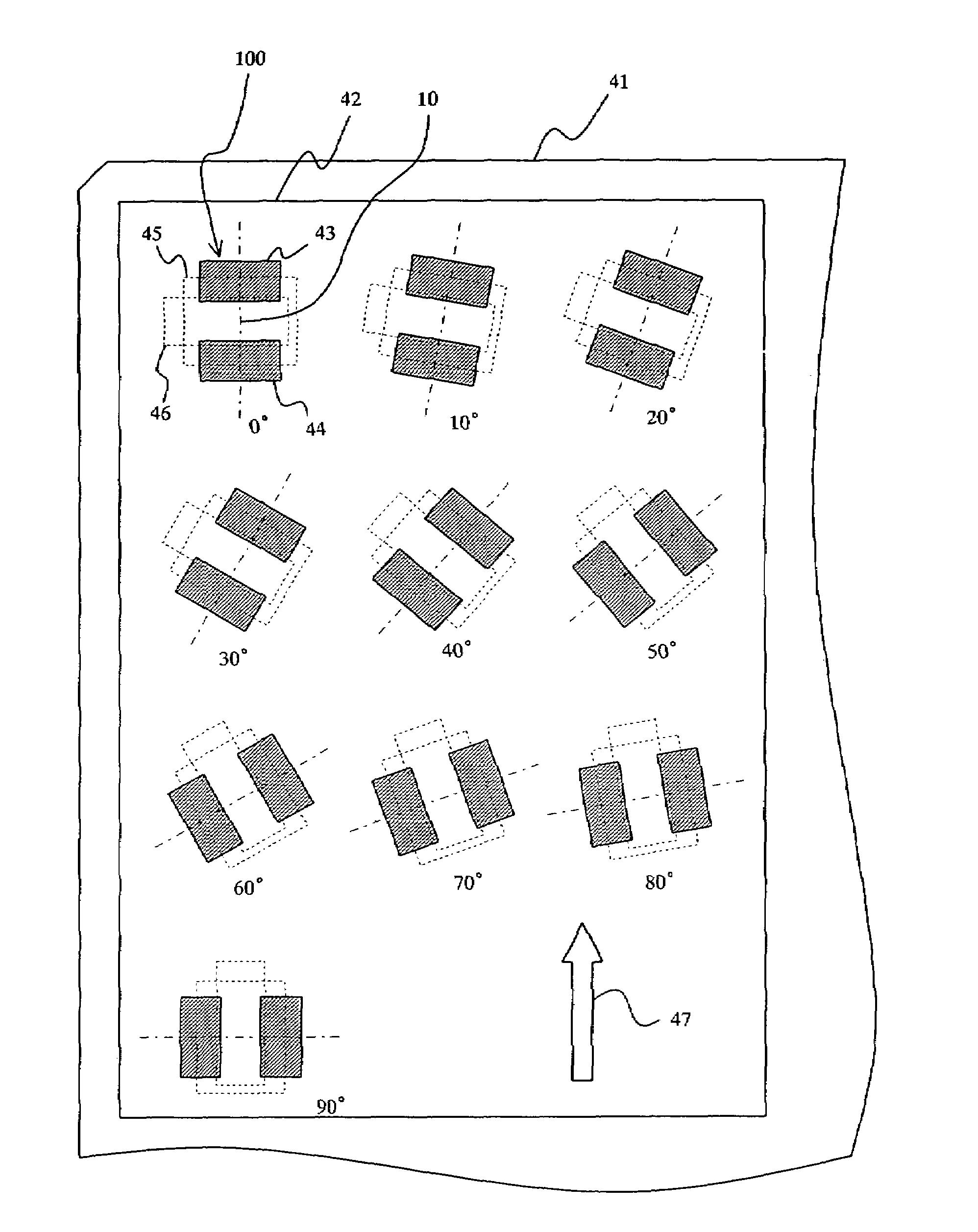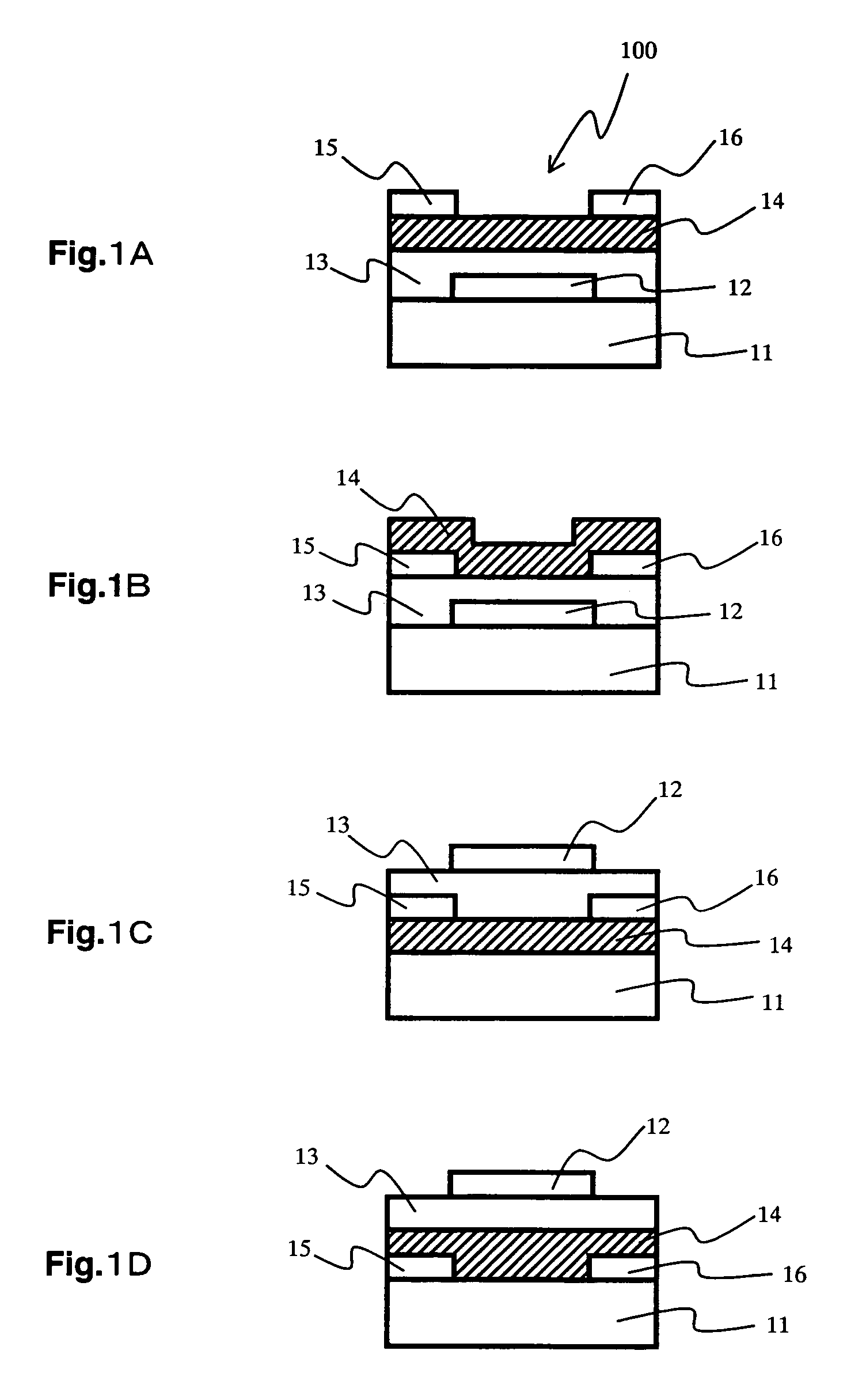Thin-film transistor and method of fabricating same
a thin film transistor and film technology, applied in the field of thin film transistors, can solve the problems of imposing restrictions on substrate materials, low cost of tfts manufacturing, and performance differences of crystalline silicon , to achieve the effect of improving performance and reducing manufacturing costs
- Summary
- Abstract
- Description
- Claims
- Application Information
AI Technical Summary
Benefits of technology
Problems solved by technology
Method used
Image
Examples
first embodiment
[0045]A first embodiment of the present invention describes a case in which an oligothiophene derivative is used as the π-conjugated organic semiconductor molecule that constitutes the semiconductor layer of a TFT.
[0046]FIG. 1 is cross-sectional views schematically illustrating first representative configurations of TFTs.
[0047]As illustrated in FIGS. 1A to 1D, various configurations are conceived as the configuration of a TFT 100 according to the present embodiment. In all the configurations, the TFT is furnished with a substrate 11, a gate electrode 12, a gate insulating layer 13, a semiconductor layer 14, a source electrode 15, and a drain electrode 16. Generally, the configurations of FIGS. 1A and 1B are referred to as the bottom gate design. On the other hand, the configurations of FIGS. 1C and 1D are referred to as the top gate design. At the same time, because of the positional relationship of the semiconductor layer 14 with the source electrode 15 and the drain electrode 16, ...
second embodiment
[0072]A second embodiment of the present invention describes a case in which pentacene is used as the π-conjugated organic semiconductor molecules that constitute the semiconductor layer of a TFT.
[0073]The present embodiment employs a TFT 100 having the configuration shown in FIG. 1B. It should be noted that the advantageous effects of the present invention are obtained by controlling the orientation direction of the semiconductor layer to be in an orientation with an appropriate angle with respect to the substrate plane. Therefore, the configuration of the TFT 100 itself is not limited to that shown in FIG. 1B.
[0074]As illustrated in FIG. 1B, the TFT 100 employing the bottom gate design has a substrate 11, a gate electrode 12, a gate insulating layer 13, a source electrode 15, a drain electrode 16, and a semiconductor layer 14 made of π-conjugated organic semiconductor molecules. Specifically, the gate electrode 12 is provided on the major surface of the substrate 11, and the gate ...
third embodiment
[0093]A third embodiment of the present invention describes a sheet-like flexible display, a wireless ID tag, and a portable device such as a portable television, a telecommunication terminal, and a portable medical device, as application examples that use the TFTs described in the first and second embodiments.
[0094]First, an example of the configuration of an active matrix-type display that employs an organic EL for its display unit will be described as the sheet-like flexible display.
[0095]FIG. 11 is a perspective view schematically illustrating the configuration of an active matrix-type display that uses an organic EL as its display unit, according to the present embodiment.
[0096]As illustrated in FIG. 11, the active matrix-type display according to the present embodiment has a TFT driving circuit 110 that is arranged on a plastic substrate 101 in an array form and is connected to pixel electrodes, and an organic EL layer 102 and a protective film 104 are arranged on the TFT driv...
PUM
| Property | Measurement | Unit |
|---|---|---|
| temperature | aaaaa | aaaaa |
| gate voltage | aaaaa | aaaaa |
| gate voltage | aaaaa | aaaaa |
Abstract
Description
Claims
Application Information
 Login to View More
Login to View More - R&D
- Intellectual Property
- Life Sciences
- Materials
- Tech Scout
- Unparalleled Data Quality
- Higher Quality Content
- 60% Fewer Hallucinations
Browse by: Latest US Patents, China's latest patents, Technical Efficacy Thesaurus, Application Domain, Technology Topic, Popular Technical Reports.
© 2025 PatSnap. All rights reserved.Legal|Privacy policy|Modern Slavery Act Transparency Statement|Sitemap|About US| Contact US: help@patsnap.com



